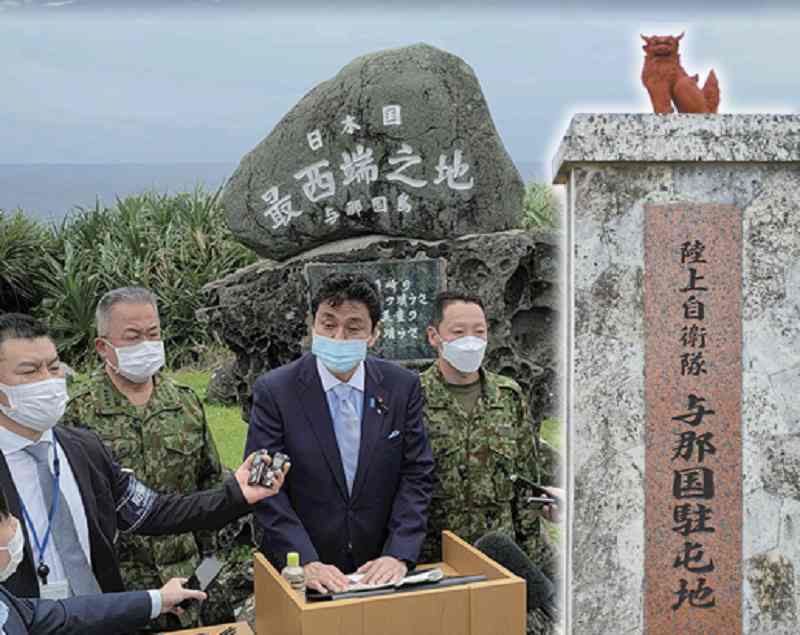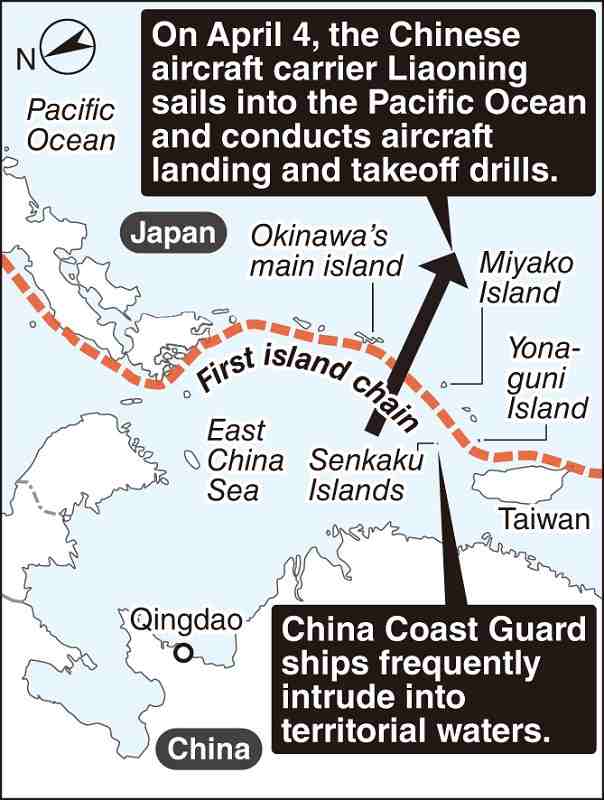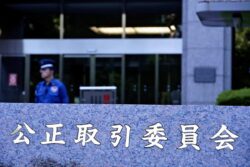
Defense Minister Nobuo Kishi answers questions from reporters on Yonaguni Island in Okinawa Prefecture, at Japan’s westernmost point, on April 17.
13:21 JST, June 29, 2022

This is the second installment of a series looking at various aspects of Okinawa today, 50 years since Tokyo and Washington agreed on its return to Japan.
During a March 16 meeting with Defense Minister Nobuo Kishi at the Defense Ministry in Tokyo, U.S. Defense Secretary Lloyd Austin stressed that the situation in Taiwan is directly linked to Japan’s national security.
The administration of U.S. President Joe Biden has heightened its sense of crisis that a Chinese invasion of Taiwan is a real threat that could happen in the near future.
The main island of Okinawa is located about 580 kilometers from Taiwan. From Okinawa Prefecture’s Yonaguni Island, which is the westernmost point of Japan, it is only about 110 kilometers to Taiwan. It is possible to see Taiwan mountains from Yonaguni.
Austin’s remark was apparently intended to warn that if a contingency involving Taiwan occurs, the safety of Okinawa Prefecture and the rest of Japan would be greatly affected. It was an unusually strong statement for a first meeting between Japanese and U.S. defense ministers, and was not mentioned at a press conference held after their talks.
Even after the return of Okinawa Prefecture to Japan, the U.S. military has consistently placed importance on stationing its troops in the prefecture. The United States has found that the prefecture holds a geographical advantage in defending Japan and responding to contingencies on the Korean Peninsula and in the Taiwan Strait.
As China has strengthened its maritime presence by building up its military power, Okinawa’s strategic importance has increased.
China’s strategy, known as A2AD (anti-access and area denial), is aimed at removing U.S. forces from the western Pacific Ocean in preparation for contingencies involving Taiwan and the South China Sea. Japanese and U.S. defense authorities assume that China will mobilize its fleet in the Pacific Ocean if the United States and China clash during a contingency, for example one involving Taiwan.
Okinawa Prefecture is situated on the “first island chain,” the line of defense that China envisages using to block the entry of U.S. forces into the East China Sea. But China is also concerned that the Nansei Islands, the island chain between Kyushu and Taiwan, are like a lid that could keep the Chinese fleet from advancing into the Pacific Ocean.
The tug-of-war over the first island chain has already begun.
Amid cloudy weather on April 4, the Chinese aircraft carrier Liaoning and missile destroyers based in Qingdao in China’s Shandong Province passed through the Miyako Strait, between Okinawa Island and Miyako Island. They sailed from the East China Sea to the Pacific Ocean.
The Liaoning then sailed to waters west of Okinotorishima island, Japan’s southernmost point, and carried out an exercise on the high seas during which carrier-based aircraft repeatedly landed and took off.
The Maritime Self-Defense Force and the U.S. Navy closely monitored the Liaoning’s activities. An MSDF destroyer and the USS Mustin missile destroyer sailed on both sides of the Liaoning at a distance of only a few thousand meters to monitor the Chinese aircraft carrier.
April 23 marked the 72nd anniversary of the founding of the Chinese Navy. On that day, The Global Times, which is under the umbrella of the Chinese Communist Party’s flagship newspaper, reported in its online edition that the Liaoning was also monitoring the USS Mustin, and that the U.S. destroyer could have been the target of a military exercise, citing the provocative view of a military expert.
The Defense Ministry believes these moves by the Liaoning were part of an exercise to secure many navigation routes into the Pacific Ocean.
The Japanese government is well aware that a Taiwan contingency cannot be separated from the defense of Japan. On the afternoon of April 17, Kishi landed on Yonaguni Island aboard a U4 multi-purpose support aircraft of the Air Self-Defense Force.
After looking toward Taiwan from an observatory on the western end of the island, Kishi visited the nearby Camp Yonaguni of the Ground Self-Defense Force.
“You all play an important role in protecting our country on the front line of border defense,” Kishi said to about 50 members of the Yonaguni coastal defense unit. “I want you to be strongly aware that the peace and stability of our country rest on your shoulders.”
The coastal defense unit was the first SDF unit on Yonaguni Island, deployed in 2016. Its mission is to monitor aircraft and ships using ground-based radar. The unit’s members are lightly armed, but in the event of a contingency, they will face enemies with weapons in their hands.
It was around 2016 that the government began to strengthen the defense of the Nansei Islands.
China unilaterally claims sovereignty over the Senkaku Islands, which are about 150 kilometers north-northeast of Yonaguni Island. China Coast Guard vessels have repeatedly intruded into Japanese territorial waters nearby. The Japanese and Chinese coast guards are keeping a close eye on each other, and tensions have escalated.
Shigeru Yonahara, a Yonaguni town assembly member who led the effort to bring the SDF camp to the island, expressed concern about the expansion of activities by the Chinese military and coast guard.
“Some people say things like, ‘I don’t feel any threat from China,’ or ‘We should solve the problem through discussions.’ However, China’s actions over the Senkaku Islands are not that simple. I want to see more SDF personnel here,” Yonahara said.
Govt mulling specific action
Based on security-related laws enacted in 2016, the government is considering specific SDF actions that could be taken in the event of a contingency involving Taiwan.
For example, if China invades Taiwan, U.S. forces stationed in Okinawa Prefecture and other areas could be mobilized to defend Taiwan. If a direct armed attack on Japan is thought to be likely if no action is taken to prevent it, the government would declare it to be a situation threatening to have a serious impact on Japan.
That would allow the SDF to engage in logistical support such as fuel supply, personnel transportation and providing ammunition to U.S. forces. Under such circumstances, SDF and U.S. military bases in Okinawa Prefecture will play a key role as a hub of operations.
If the situation worsens and Okinawa Prefecture or other parts of Japan come under an armed attack, the government would declare it to be a situation involving an armed attack. That would allow the SDF to be mobilized for defense and to stage counterattacks together with U.S. forces.
Even if the situation does not lead to a direct attack on Japan, if the nation’s existence is threatened, the government could deem it to be an existential crisis. In that case, Japan could fight back based on its limited right of collective self-defense. However, such decisions are expected to be made carefully, as the security-related laws have set strict requirements for the government to declare this situation.
"Politics" POPULAR ARTICLE
-

Japan to Support Central Asian Logistics Route That Bypasses Russia, Plan to Be Part of Upcoming Summit in Tokyo
-

Japan to Tighten Screening of Foreigners’ Residential Status by Providing Information of Nonpayment of Taxes
-

Chinese, Russian Bombers Flew Unusual Path by Heading Toward Tokyo; Move Likely Meant to Intimidate Japan
-

Japan Plans National Database to Track Foreign Ownership of Real Estate, Land as It Weighs New Rules
-

Up to 199,000 Deaths Estimated From Mega-Tsunami; Most Recent Occurrence Took Place in 17th Century
JN ACCESS RANKING
-

Tokyo Economic Security Forum to Hold Inaugural Meeting Amid Tense Global Environment
-

Keidanren Chairman Yoshinobu Tsutsui Visits Kashiwazaki-Kariwa Nuclear Power Plant; Inspects New Emergency Safety System
-

Imports of Rare Earths from China Facing Delays, May Be Caused by Deterioration of Japan-China Relations
-

University of Tokyo Professor Discusses Japanese Economic Security in Interview Ahead of Forum
-

Japan Pulls out of Vietnam Nuclear Project, Complicating Hanoi’s Power Plans



-250x167.jpg)






















